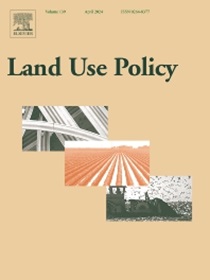土地利用变化对乌尔米耶湖盆地当地沙尘事件的影响
IF 6
1区 社会学
Q1 ENVIRONMENTAL STUDIES
引用次数: 0
摘要
土地利用变化是气候变化和全球变暖的一个有效因素,它对碳循环、辐射能量平衡和灰尘产生都有影响。由于土地利用变化、干旱和气候变化,伊朗西北部的乌尔米耶湖流域水量平衡处于危急状态。这一过程导致湖泊水域面积减少和明显的沙尘产生。卫星图像显示,从 1984 年到 2017 年,乌尔米耶湖流域 1433 平方公里的牧场和水域面积减少了 2906 平方公里。人类居住区面积增加了 550 平方公里,灌溉农田和果园面积增加了 804 平方公里,盐沼面积增加了 3428 平方公里。WetSpass 水文模型的输出结果显示,乌尔米耶湖盆地东部的蒸散系数和截流变化最大。这些变化的影响表现在土壤水分减少、盐碱沼泽增加以及作为潜在沙尘资源的软沉积物。在研究期间,湖北部和东部的沙尘日频率增加了 2.5 倍,而南部和西部则增加了 6 倍。佩蒂特测试结果表明,这些变化从 2007 年开始出现。回归和相关测试证实,盐沼和软沉积物占灰尘变化的 75%,而乌尔米耶湖面积的减少占灰尘变化的 64%以上。评估结果表明,足迹对自然环境和湖泊盆地的水量平衡造成了破坏。为解决这一问题,建议采取的战略包括:修订水资源管理和湖泊环境用水权,在降低水需求的基础上改变发展战略,从农业发展转向非农业发展,以及减少蓄水坝。本文章由计算机程序翻译,如有差异,请以英文原文为准。
Effects of land use changes on local dust event in Urmia Lake basin
Land use change is an effective factor in climate change and global warming, which contributes to the carbon cycle, radiant energy balance, and dust production. Urmia Lake basin water balance in the Northwestern part of Iran is in a critical condition due to land use change, drought, and climate change. This process has led to the lake water area reduction and pronounced dust production. The satellite images indicate that from 1984 to 2017, 1433 Km2 rangelands and water area of the Urmia Lake basin decreased by more than 2906 Km2. The area of human settlement increased by 550 Km2, irrigated farmland and orchards, 804 Km2, and salty marsh, 3428 Km2. The outputs of the WetSpass hydrological model reveal the highest coefficient of evapotranspiration and interception variation in the East of Urmia Lake basin. The effects of these changes are observed in reduced soil moisture, increased salty marsh, and soft sediments as potential dust resources. During the study period, the frequency of dust days in the North and East of the lake increased 2.5-fold, while in the Southern and Western parts increased 6-fold. The results of the Pettitt Test indicate that these changes began to appear in 2007. The regression and correlation test confirm that salt marshes and soft sediments account for up to 75 %, and the decrease in the area of Urmia Lake for more than 64 % of the dust changes. The results of the assessments indicate the contribution of footprint in the destruction of the natural environment and the water balance of the lake basin. Revision of water resources management and environmental water rights of the lake, changes in the development strategy from agriculture to non-agriculture development based on lower water demand, and reduction of storage dams are among the recommended strategies to address this problem.
求助全文
通过发布文献求助,成功后即可免费获取论文全文。
去求助
来源期刊

Land Use Policy
ENVIRONMENTAL STUDIES-
CiteScore
13.70
自引率
8.50%
发文量
553
期刊介绍:
Land Use Policy is an international and interdisciplinary journal concerned with the social, economic, political, legal, physical and planning aspects of urban and rural land use.
Land Use Policy examines issues in geography, agriculture, forestry, irrigation, environmental conservation, housing, urban development and transport in both developed and developing countries through major refereed articles and shorter viewpoint pieces.
 求助内容:
求助内容: 应助结果提醒方式:
应助结果提醒方式:


